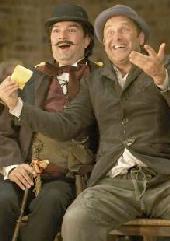SEARCH CurtainUp
REVIEWS
FEATURES
NEWS
Etcetera and
Short Term Listings
LISTINGS
Broadway
Off-Broadway
BOOKS and CDs
OTHER PLACES
Berkshires
London
LA/San Diego
DC
Philadelphia
Elsewhere
QUOTES
On TKTS
LETTERS TO EDITOR
FILM
LINKS
MISCELANEOUS
Free Updates
Masthead
NYC Weather
 London Review
London Review
Pedro the Great Pretender
by Charlotte Loveridge
|
. . . But this great Pedro of whom I talk,
He could create, I am sure, a marvel from a cabbage stalk.
--- Martin Crespo |

Julius D'Silva (Martin Crespo), John Ramm (Pedro).
(Photo: Manuel Harlan) |
The play follows the fortunes of Pedro de Urdamales: an Odysseus of Spanish folktale, a dissembler and storyteller extraordinaire. Famed for his ingenuity and cunning, he is the epitome of the "picaro", a rogue who lives by his wits. Rather than a traditional, coherently-developing plot, the play presents a number of separate vignettes, the only continuity of which is the display of Pedro's resourceful wiliness.
John Ramm makes a genial and relaxed Pedro, who seems to achieve these feats of ingenuity with effortless ease. His dark, intelligent eyes twinkle with amusement while his expressive mouth is extraordinarily mobile. The audience cannot help but be beguiled into an amused complicity with his benevolent chicanery. His finest escapade sees him in the guise of a monk, complete with smoking cassock and clairvoyant powers, as he extorts a fortune from a widow who is at once miserly and superstitious.
The fact that many of the episodes are drawn from a folktale tradition which we do not share, lend a slightly surreal aspect to some scenes. In one episode, a shepherdess sits with her feet in water hoping to hear the name of her fated husband. In another, Pedro plucks random judgements from the mayor's hood, providing haphazard sentences to the claimants present. The variety of scenes discloses a panoramic vista of seventeenth-century Andalucian society: from gypsies to royalty and from the bucolic to the bourgeois. Only the mercurial Pedro can cross these social boundaries without difficulty and thus provides the unifying impetus to the play's action.
The ensemble company give lively support to John Ramm's role. Their fresh, energetic approach fits well with the vibrancy of this rediscovered play. In particular, Joseph Millson was outstandingly funny in his two roles as a scurrilous, blind con-artist who is outdone by Pedro, and as the king torn between his infatuation with a beautiful gypsy and his queen's uxorial jealousy. Other notable performances included Claire Cox (Belica) as the ambitious gypsy, who is assured of her predestined social betterment, and Julius D'Silva (Martin Crespo) as the mayor endowed with magnificent mustachios and malapropisms.
Philip Osment's new translation dextrously interweaves different verse patterns in an attempt to reflect the metrical complexity of the original. At times displaying dazzling verbal pyrotechnics, Osment incorporates varied rhyming schemes, assonance, alliteration, paranomasia and some modern colloquialisms. The colourful visual spectacle and the spirited music and dance likewise help to vivify this long-neglected text for a twenty-first century audience.
Mike Alfreds' direction emphasizes the self-conscious theatricality of the play: Pedro steps forward to introduce each new episode and the cast sit onstage as a second audience when not involved in the action. Although this approach may at first seem slightly unwarranted, as the play progresses, it becomes clear just how thoroughly appropriate it is. Encountering by chance a couple of actors who immediately see through his trickery, Pedro realises that his versatile and chameleon-like skill suits him perfectly for the acting profession. Renaming himself Cervantes, he declares that only as an actor will he fulfil the prophecy of his greatness, since he can assume any social role he wishes onstage. Refusing to allow the audience to witness his stage debut, he cheekily invites us back for tomorrow night's performance. With so absolute a metatheatrical coup, it is hard not to think of Brecht or Pirandello and it is even more astonishing to remember that this play predates such postmodernism by three centuries.
Laurence Boswell's ambition to rediscover drama from the Spanish Golden Age is of course extremely laudable, but also hampers this production with all the drawbacks of unfamiliarity. However, although the audience at first seemed slightly nonplussed and baffled by the fragmented episodes, they soon learnt to enjoy the play for what it is: a social comedy which views humanity with Cervantes' trademark combination of wit, irony and compassion.
| Pedro the Great Pretender
Written by Miguel de Cervantes Saavedra Translated by Philip Osment Directed by Mike Alfreds With: Claire Cox, Katherine Kelly, Emma Pallant, Joanna Van Kampen, Peter Sproule, Rebecca Johnson, Julius d'Silva, James Chalmers, Vinta Morgan, Oscar Pearce, Joseph Millson, Simon Trinder, Joseph Chance, John Ramm, Oliver Williams, John Stahl, John Wark, William Buckhurst, Melanie MacHugh Set Designer: Es Devlin Design by Rae Smith Lighting: Ben Ormerod Sound recreated by Tim McCormack Music composed by Ilona Sekacz Music Director: Michael Tubbs Choreography: Leah Hausman Running time: Three hours with one interval Box Office: 0870 060 6631 Booking to 12th March 2005. Reviewed by Charlotte Loveridge based on 17th February 2005 performance at the Playhouse, Northumberland Avenue London WC2 (Tube: Embankment) |


Mendes at the Donmar
Our Review

Peter Ackroyd's History of London: The Biography

London Sketchbook

Retold by Tina Packer of Shakespeare & Co. Click image to buy.
Our Review

6, 500 Comparative Phrases including 800 Shakespearean Metaphors by CurtainUp's editor.
Click image to buy.
Go here for details and larger image.
